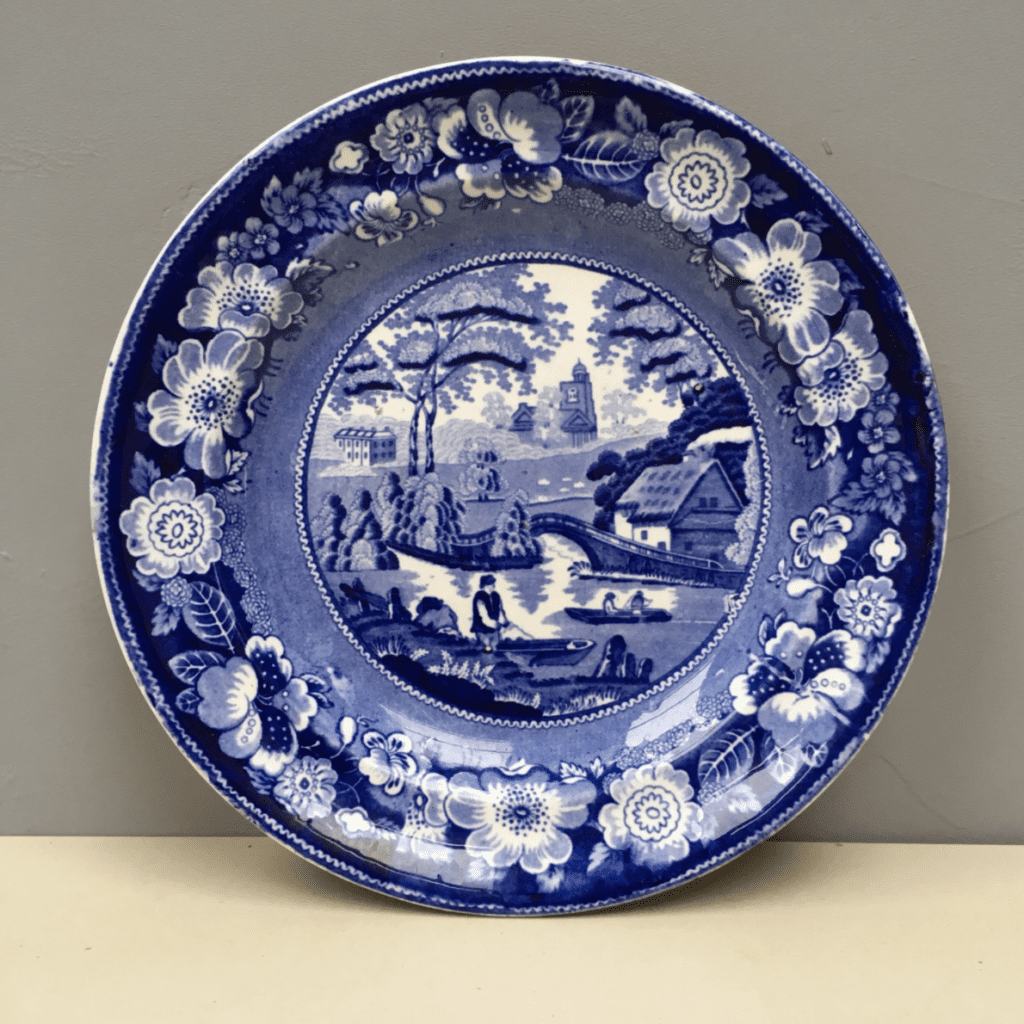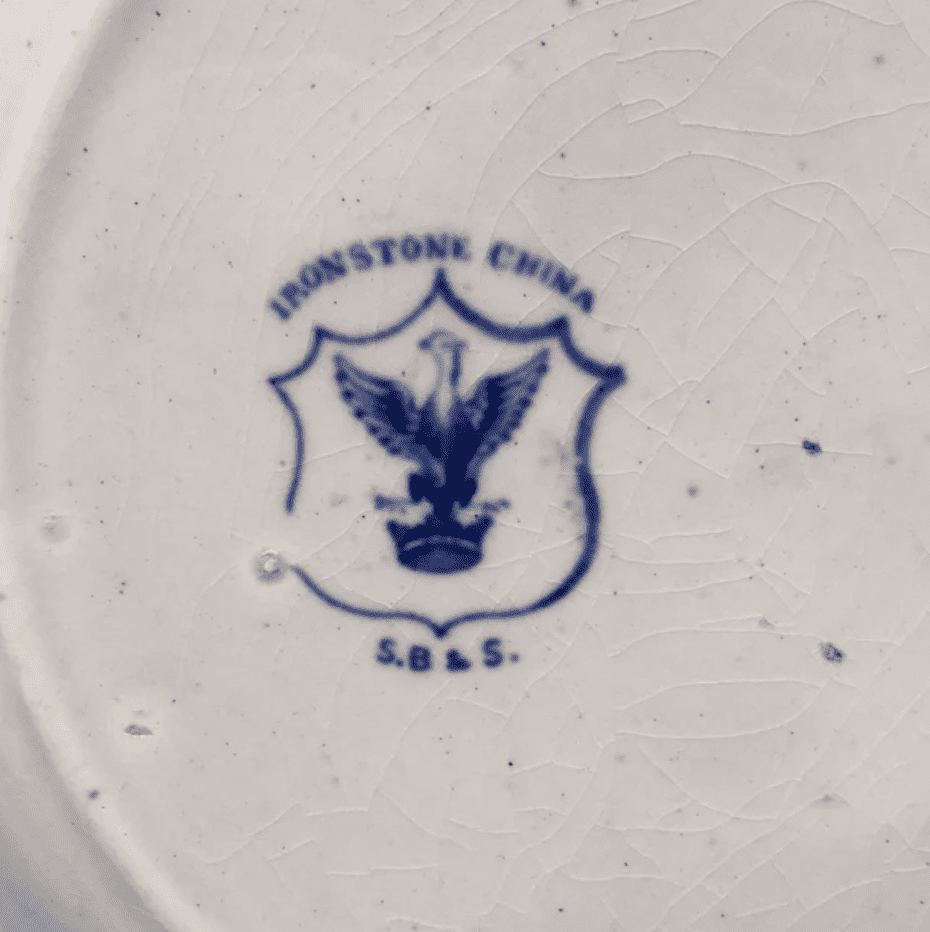Churchill is one of only a few companies that still produce Blue Willow China today. Because Blue Willow China has been produced by so many companies over the years, it can be difficult to identify which pieces are considered Churchill Blue Willow.
While Blue Willow china was originally produced in the 1780s, Churchill Blue Willow china was first made in 1818 by Sampson Bridgwood. Samuel Bridgwood and Sons company was acquired several times, and didn’t become part of Churchill until 1990.
Like many other vintage pieces, Churchill Blue Willow china has a unique history. Keep reading to learn more about this popular product’s story. Let’s get started!

What is Churchill Blue Willow?
The first Blue Willow china pieces were made around the 1780s, but Churchill didn’t begin producing blue willow pattern until 1818 under Sampson Bridgwood/Samuel Bridgwood and Sons. [Source]. It’s a rather complicated history!
See below a rare vintage Blue Willow plate, marked with an “S.B. & S.” on the back, Samuel Bridgwood and Sons.


The blue willow patterns were derived from traditional Chinese pottery. Blue Willow china pieces, including Churchill Blue Willow items, feature traditional Chinese scenes telling various stories. Many patterns tell the story of Koong-se and her love for her father’s secretary, Chang. However, the father disapproved of their love so they ran away together. You may see various parts of this story on your Churchill Blue Willow pieces.
Original Blue Willow china pieces had their patterns painted on them using a copper plate. This meant that no two pieces had the exact same pattern painted on them. In other words, different parts of the story were told in different ways. This has led to a large variety of designs, and different interpretations of Koong-se’s story. With advancements in production technology, Blue Willow china was able to be mass-produced all over the world. Today, many pieces use the same pattern rather than featuring a unique painting.
To some’s surprise and dismay, the story of Koong-se and her lover Chang is not real. The story was created as part of a marketing strategy when the pieces were first released. Even if the story isn’t true, many still consider it a tale of true love.
These pieces were made by hundreds of different manufacturers in England and around the world. Check out our full article for more information about all the different places Blue Willow has been made.
Where is Churchill Blue Willow Made?
Although Blue Willow patterned china was made all over the world, Churchill Blue Willow pieces were all manufactured in England.
The history of Churchill Blue Willow is a bit complicated, as it actually ran under the name of Samuel Bridgwood & Sons when it was originally produced in 1818, and it wasn’t even produced under the Churchill name until the 1990s. [Source] See the Churchill China company website for more information.
The Churchill China company was listed on the London Stock Exchange in 1994. By 2001, the company was named number one in the United Kingdom Hospitality Market. The next year, the Churchill company expanded to the United States.
While Churchill China company originally produced its Blue Willow pieces in England, today the company has expanded to have several showrooms.

According to the Churchill website, there are three warehouses that house the worldwide Churchill stock, which is more than 7 million pieces! Not all of these pieces feature the Blue Willow pattern. Churchill warehouse can be found in the United Kingdom, the Netherlands, and the United States.
Since the company has been in operation for more than 200 years, Churchill strives to provide quality products to its customers. Today, this translates to a 5-year edge chip warranty. Only certain pieces are covered under this warranty.
Today you can purchase Blue Willow pieces at places like your local Walmart. However, these pieces are worth only a couple of dollars and are considered to be of lesser quality than vintage Blue Willow china.
Is Churchill Blue Willow China Valuable? How to Tell

Churchill Blue Willow china was marketed to people of all income levels. For this reason, they weren’t sold at significantly high prices. Keep in mind that if a Blue Willow item is marked Churchill, then it probably wasn’t produced until after 1990.
The Churchill Blue Willow pieces that are worth the most are those with lids and teapots. Unique pieces that were not mass-produced may be worth more than commonplace items such as dinner plates.
As you can imagine, the better condition of the piece, the more it is worth. If your Churchill Blue Willow piece has any cracks or chips, it will be worth a lot less.
Churchill Blue Willow dinner plates, bowls, cups and saucers can be found individually in the $8-20 price range. Churchill Blue Willow dinner sets usually sell for around $149 – $229 price range. Specialty items in Churchill Blue Willow, such as teapots, sugar bowl and creamer sets, and cake stands, sell for between $59 to several hundred dollars.

Look on antique sites, Etsy, and eBay to compare your piece with similar items.
If you’re unsure about the value of your Blue Willow china piece, visit an antique appraiser. This professional can give you an accurate idea of what your Churchill Blue Willow china piece is worth.
Is Churchill Blue Willow Safe to Use?
Many of the original Churchill Blue Willow china pieces do contain lead. This lead was usually added to the ceramic piece’s glaze to ensure a glossy finish. Unfortunately, many use these collectors’ dishes to eat off of, exposing themselves to deadly levels of lead.
According to the Center for Disease Control, the Food and Drug Assistance limits the safe level of lead exposure to less than 3 micrograms per milliliter. In 2003, a ceramic plate was found to contain 29.6 micrograms per milliliter of lead. This problem was identified after a child became seriously ill after eating from the plate.
Before you eat off a piece of vintage–and even some more modern–Blue Willow china pieces, test it for lead. You can purchase at-home lead test kits or take the piece to a lab. Keep in mind, some tests will be more destructive to the piece than others.
Be sure to keep pieces that test positive out of your children’s reach, especially because children are more sensitive to the effects of lead poisoning.


